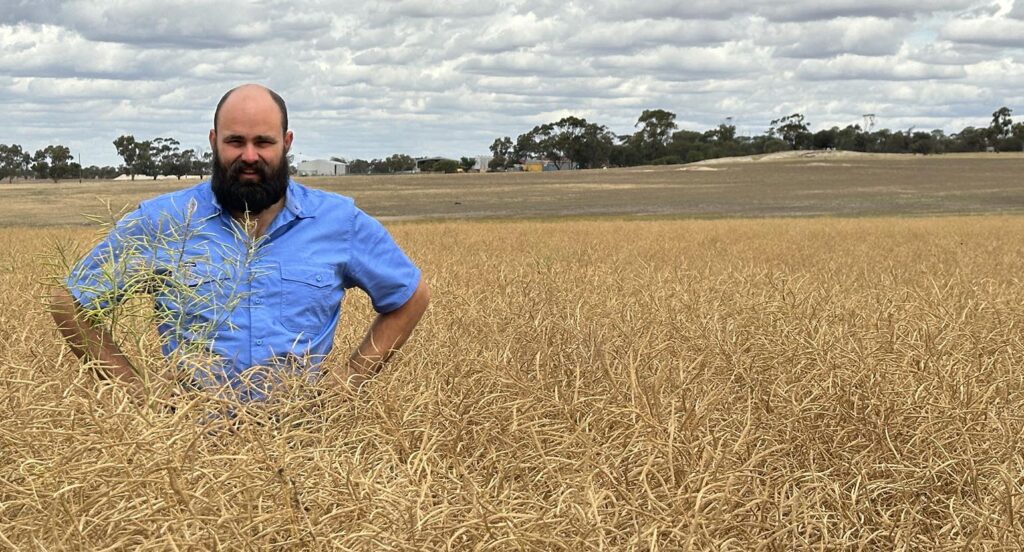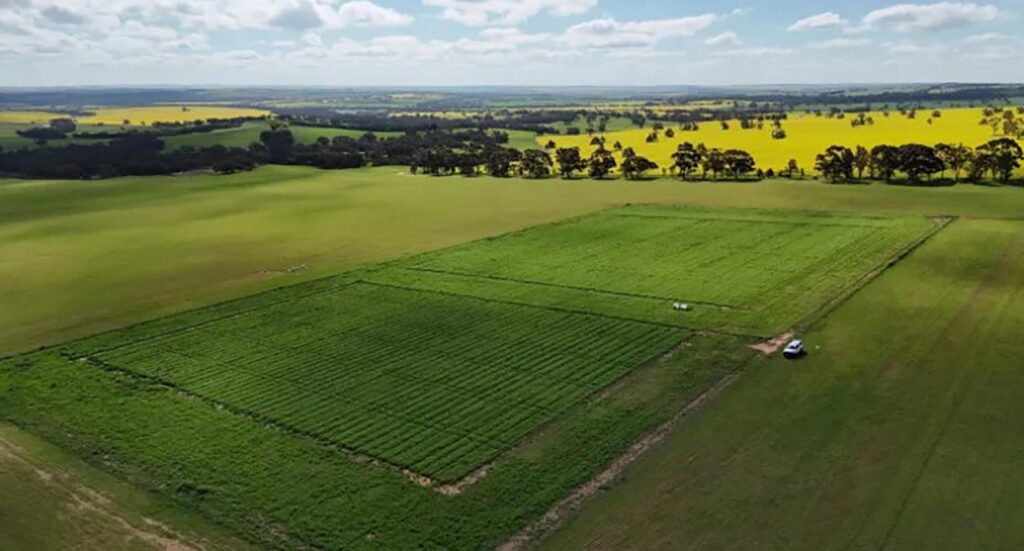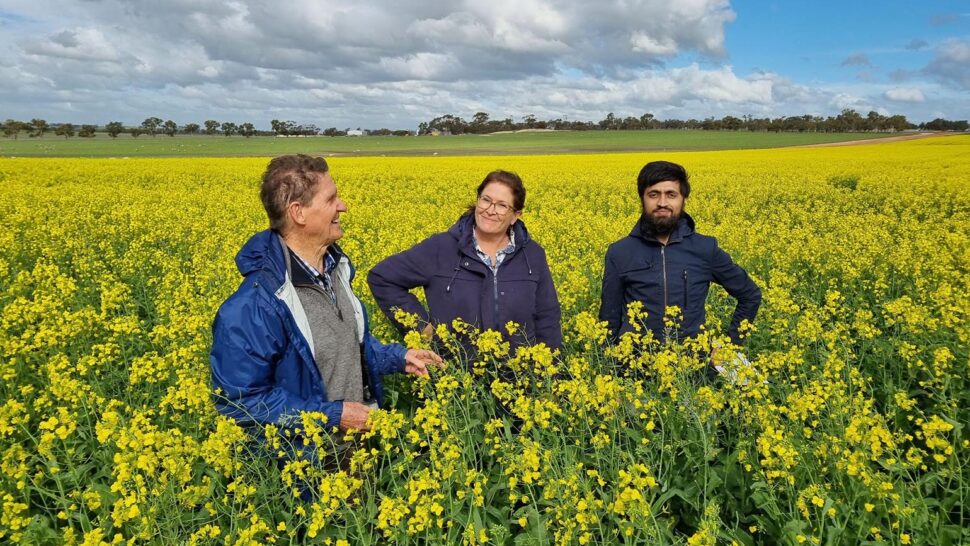There is considerable interest in soil carbon sequestration and the potential for new farming practices to improve the supply of nutrients from organic sources, minimise losses and increase soil carbon stocks.
The Soil CRC’s ‘New farming methods to sequester soil carbon’ project (4.1.006) is using a farming systems approach to investigate 3 potential new methodologies for carbon sequestration — crop sequencing (including summer crops, cover crops and pastures), soil carbon amendments and soil amelioration.
The project aims to trial, measure and demonstrate crop sequencing and new technologies that can sequester organic carbon, mitigate greenhouse gas emissions and improve soil fertility in crop production systems that have traditionally struggled to accumulate carbon.
“The project team is using 4 long-term field sites based in Western Australia to investigate new soil and farm management opportunities,” said Soil CRC Project Leader Dr David Minkey from the Western Australian No-Tillage Farmers Association.
“The trial sites are skilfully managed by the Soil CRC’s local grower groups — Corrigin Farm Improvement Group, Facey Group, Liebe Group and West Midlands Group — with support from researchers at Murdoch University.
“They’re conducting ongoing site monitoring and measuring changes in crop yield, soil carbon levels and soil health indicators to evaluate the impact of the selected management practices.”
Co-funded by the Western Australia Department of Primary Industries and Regional Development through the Western Australian Carbon Farming and Land Restoration Program, the project also seeks to determine if these practices can assist growers to participate in carbon trading schemes.
Field sites update
The final harvest was completed at each field site late last year, concluding the field trial component of the project. The data collated from each site has now been analysed.
Bullaring
The Bullaring site is managed by Facey Group and was established in 2022 as a randomised block with 7 crop treatments including soil disturbance, clay amelioration, mixed cropping with inter-row legumes and a perennial legume.
The Bullaring field experiment has revealed that potential plant productivity improvements could be achieved on unfertile sands using perennial legumes and soil amelioration approaches. Soil structural disturbance and clay incorporation has improved the reactivity, nutrient retention and weed competition for soil moisture in deep a sandy soil.
The 2024 trial results showed that deep ripping, clay amendments, and crop sequencing influence soil health and productivity. While clay incorporation improved soil moisture and nutrient retention, late-season drought limited its impact on yield.
Serradella and mixed cropping enhanced phosphorus availability, supporting long-term soil fertility. However, increased sodium and magnesium in clay-treated soils highlight the need for careful management.
The findings emphasise that soil improvements must be paired with effective water management to maximise benefits, guiding toward more resilient and sustainable farming systems.
The trial has been extended for a further 4 years as part of another Soil CRC project, enabling longer term analysis to occur.
Coorow
Liebe Group is managing the Coorow site, where bentonite clay and chicken manure amendments were applied in 2022. While a crop was sown in 2023, the subsequent dry conditions meant the site was unable to establish a cover crop until 2024.
The site was then sown to triticale on the first rain of the season, and basal and nitrogen were applied. On a poor sand, with limited production history, adding clay and organic matter increased the water holding capacity of the soil, in turn increasing plant health, biomass and yield.
Results indicate that the amount of clay has produced greater fluctuations in the crop yield than change in the amount of nitrogen. Therefore, in the given conditions, changing the clay component of the soil may alone provide greater benefits than adding nitrogen-rich fertilisers.
Noticeably, yield received from the clay applied at 80 t/ha is statistically not different than the control (no clay), while clay applied at the rate of 160 t/ha has produced significantly greater yield over the control. This implies that clay applied at a rate lower than 160 t/ha may not provide any yield benefits in the given conditions.
Kweda
Kweda is managed by Corrigin Farm Improvement Group (CFIG), who have been working with a local grower to undertake this fieldwork. Two trials were established in 2022—a large on-farm experiment and a complementary small plot trial—to evaluate a range of organic and inorganic amendments and deep ripping.
Earlier in the experiment, the large plot trial at Kweda showed improvement between the unripped (control) and the ripping treatments. Gypsum was recognised as the most beneficial amendment, but no significant differences were observed for plant establishment and plant health.
The small plot trial investigated a series of novel amendments and variable rates, all incorporated by the ripper. Early results showed no significant differences for plant establishment and grain yield.
The site was sown to canola in 2024, with the final harvest completed in December. In both the large plots experiment and small plots experiment, differences were observed between the treatments in terms of the soil properties. For instance, the soil treated with compost + Bednar in the large plots was found with a significantly greater nitrate nitrogen and DTPA copper in the top 10 cm of the soil, as found in 2024, relative to the control.
Similarly, the compost treated soil in the small plots had significantly greater values of phosphorus, potassium, DTPA copper, DTPA zinc, exchangeable calcium, exchangeable magnesium, exchangeable potassium, exchangeable sodium and boron in the top 10 cm. However, these changes in the soil properties were not reflected in the yield and no significant differences were observed in the yields of different treatments in 2024.
As with the Bullaring trial, the Kweda trial will also continue for another 4 years.

Wathingarra
Managed by West Midlands Group, Wathingarra is an existing long-term site that is being used to investigate the effect of inorganic and organic soil amendments on carbon sequestration and soil health.
The trial has looked at a combination of amendments (biochar, frass, biochar and frass, compost, zeolite, clay-compost, gypsum and local clay), which were incorporated using mouldboard ploughing, rotary spading or shallow tillage, compared to an untreated control.
Combining various amendments and amelioration did not increase grain yield at the Wathingarra site. The compost or rotary spading applied in 2021 significantly increased grain yield in 2022 compared to their respective treatments, but biochar and/or frass did not. In the absence of mouldboard ploughing or rotary spading, there was a trend of increased crop growth and grain yield with the application of biochar and/or frass.
The site was sown to Sarredella in 2023 and showed similar gains in biomass to mouldboarding and compost.
The Wathingarra trial will also be extended for a further 4 years.
Visit West Midlands Group’s project webpage to find out more about this site.

Next steps
The project is on-track to wrap up in mid-2025 with the final report expected to be released later this year.
The project team will also work with the Western Australia Department of Primary Industries and Regional Development to carry out carbon workshops as part of a statewide extension project.
The Kweda, Bullaring and Wathingarra trials are continuing as part of a Soil CRC project (6.4.002) funded by the Australian Government’s Future Drought Fund.
Led by Dr Richard Bell from Murdoch University, the project is evaluating drought resilience in different farming systems and soils through the Soil CRC’s established network of long-term trials across multiple sites in Western Australia, New South Wales and Victoria.
Further project results will be published on the Soil CRC website.
Find out more
Main image (top): CFIG’s Executive Officer Joy Valle (centre) stands in the canola crop at the Kweda field site in WA with Soil CRC and Murdoch University researchers, Prof Richard Bell (left) and Dr Hassan Sardar. Source: CFIG.

